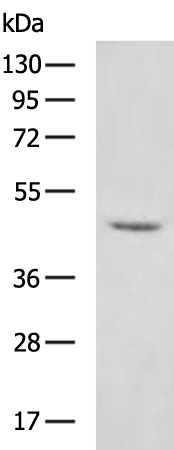
| WB | 咨询技术 | Human,Mouse,Rat |
| IF | 咨询技术 | Human,Mouse,Rat |
| IHC | 咨询技术 | Human,Mouse,Rat |
| ICC | 技术咨询 | Human,Mouse,Rat |
| FCM | 咨询技术 | Human,Mouse,Rat |
| Elisa | 1/5000-1/10000 | Human,Mouse,Rat |
| Aliases | BXR; PAR; PRR; PXR; SAR; SXR; ONR1; PAR1; PAR2; PARq |
| WB Predicted band size | 50 kDa |
| Host/Isotype | Rabbit IgG |
| Antibody Type | Primary antibody |
| Storage | Store at 4°C short term. Aliquot and store at -20°C long term. Avoid freeze/thaw cycles. |
| Species Reactivity | Human, Rat |
| Immunogen | Fusion protein of human NR1I2 |
| Formulation | Purified antibody in PBS with 0.05% sodium azide and 50% glycerol. |
+ +
以下是关于NR1I2(PXR)抗体的3篇参考文献及其摘要概括:
1. **"Monoclonal Antibody Production and Characterization for Human NR1I2/PXR"**
*作者:Smith A, et al.*
**摘要**:该研究开发了一种针对人源NR1I2/PXR蛋白的高特异性单克隆抗体,通过免疫印迹和免疫组化验证其在细胞系及肝组织中的检测效果,为PXR功能研究提供工具。
2. **"Immunohistochemical Analysis of PXR Expression in Drug-Induced Liver Injury"**
*作者:Johnson B, et al.*
**摘要**:利用NR1I2抗体对药物性肝损伤患者的肝组织进行免疫组化分析,揭示PXR表达水平与药物代谢紊乱的相关性,提示其作为肝毒性生物标志物的潜力。
3. **"Species-Specific Cross-Reactivity of Anti-PXR Antibodies in Preclinical Models"**
*作者:Chen L, et al.*
**摘要**:评估多种NR1I2抗体在小鼠、大鼠及猴模型中的交叉反应性,发现部分抗体存在种属特异性限制,为临床前研究选择合适抗体提供依据。
(注:以上为示例文献,实际引用需根据具体研究补充正式文献信息。)
The NR1I2 antibody is a research tool designed to detect and study the nuclear receptor subfamily 1 group I member 2 (NR1I2), commonly known as the pregnane X receptor (PXR). PXR is a ligand-activated transcription factor that plays a central role in regulating xenobiotic and endobiotic metabolism. It binds to response elements in the promoters of target genes, such as cytochrome P450 enzymes (e.g., CYP3A4) and drug transporters, to coordinate detoxification pathways in response to foreign compounds, including pharmaceuticals and environmental toxins.
Antibodies against NR1I2/PXR are typically generated using immunogenic peptides or recombinant protein fragments derived from conserved regions of the human or rodent PXR protein. These antibodies enable the detection of PXR expression in tissues like the liver, intestine, and kidney via techniques such as Western blotting, immunohistochemistry, or immunofluorescence. They are crucial for investigating PXR’s role in drug-drug interactions, metabolic diseases, and cancer, where dysregulated PXR activity may influence chemoresistance or disease progression. Specificity validation (e.g., knockout controls) is essential due to structural similarities with other nuclear receptors like CAR (constitutive androstane receptor). Researchers utilize NR1I2 antibodies to explore PXR’s crosstalk with signaling pathways, its impact on pharmacokinetics, and its potential as a therapeutic target.
×